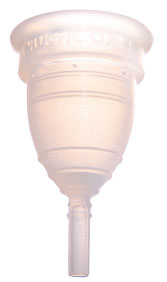A small study published this month in the Journal of Obstetrics & Gynaecology tested effectiveness of the mooncup. The results won’t surprise anyone who has used one: “The Mooncup leaked 0.5 times less frequently and required to be changed 2.8 times less frequently, on average, during one menstrual period than regular sanitary protection.”



THIS IS NOT NEWS! 😉 😀
Ha! Of course, you’re right, Jaleesa. What’s newsworthy is that a prestigious medical journal published this ‘news’.
Oh, I see. 🙂
The Mooncup is only one of over a dozen different brands of Menstrual Cups and they all vary in size. A cup that doesn’t fit right can be uncomfortable and/or leak. There is a learning curve involved so success might not be immediate. But enthusiastic cup users agree that it’s well worth getting to know how to use them. https://community.livejournal.com/menstrual_cups/2069973.html
Actually, it is some pretty big news, considering how “green” menstrual cups are. There’s so much waste reduction from women who use these instead of pads and/or tampons. They’re significantly cheaper-one $15-50 time cost, and that’s it. Instead of buying $5-20 per month per period, that one cup will last you years.
It also requires far less changing, and there is NO RISK OF TSS ASSOCIATED WITH CUP USE unlike tampons.
So yeah, I’d say this is darn exciting news. I only wish more women were open-minded to trying them. It’d help their wallets, their bodies, and the environment so, so very much.
The qualities of Mooncups, and many other cups, are not news to all of us happy cup users out there. We’ve known it for a long time. But I do agree that it’s great news that a study was done and results were published… as it may help the rest of the world see what a great alternative cups are for many of us!
I think you’re seriously overestimating the amount of leakage, at least post-learning curve. (And the “learning curve” isn’t particularly long, nor is it inevitable for every woman.) My experience was “Average number of leaks with tampons: 3-4 per period” v. “TOTAL number of leaks with DivaCup: precisely one leak in two years of use.”
Louise, while I understand that you leak rarely with your cup, I’m not sure how that translates into overestimating leakage in general. It may well be that there are other cup users — perhaps even the majority of cup users — who continue to experience some regular leakage, albeit less leakage than they did with a pad or tampon.
Indeed – the leakage figures of “0.5 times less frequently” than with disposable products is based on an average of 71 cycles, compared to 126 baseline cycles. I don’t have ready access to the full study, but these figures were all cited in the abstract.
Wait… so all of these findings were recorded during the first three cycles that these women were using the Mooncup? Yeah, then you should totally expect results to get even better later on. For most of us, the first one to three cycles can be considered to fall within the learning curve.
So I would definitely not see these results as representative of normal use.
Still, yay positive publicity.